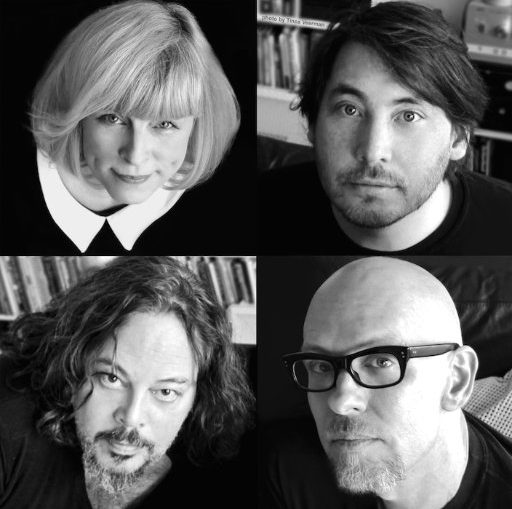Bettie Serveert
Wednesday March 2, 2005
Stubb’s BBQ Austin
by Andy Smith

An alliance of negative forces combined to keep the crowd away from Bettie Serveert’s first Austin appearance since their South by Southwest showcase in 2004 where they emerged from the back of my mind in stunning fashion.
First, the show was on a Wednesday, which is often a quiet night among Austin music clubs. Secondly, the weather was damp, foggy, and chilly; a night when it was very tempting to just lie on the couch and watch a movie instead of driving on damp streets. There was also no opening band to draw in their fans, and the band is touring at a time where their new record, Attagirl, is still very new to their American audience. Throw in the fact that the date of the show put it during the time, two weeks before SXSW, when many locals are saving their energy and money for the conference’s musical bonanza, and you have the recipe for a disappointing crowd numbering in the dozens instead of in the hundreds.
The band was visibly disappointed as they walked through the club before the show, but any concerns and frustrations were put aside when they took the stage. Opening with “Dreamaniacs” the effortlessly tuneful lead-off track from Attagirl, Bettie Serveert played a wonderful two-hour set that effectively blended the more electronic pop elements of their new record with the edgy indie guitar rock they have made their career on.
Augmented by keyboard player and sample-keeper Martijn Blankestijn and a splendid drummer referred to as “Gino G. from Italy,” the band’s three original members: singer/guitarist Carol Van Dijk, guitarist Peter Visser and bassist Herman Bunskoeke played seamlessly. Van Dijk’s voice, which has always been winning but not always powerful, sounds much stronger and more fluid than it did on the early records. She also has a natural charisma and sultriness that are reminiscent of Chrissie Hynde’s combination of streetwise assertiveness and vulnerability.
Visser’s wild careening guitar style had more taste and soul to it that sometimes comes across on records. His leads are still mainly about the barbed-wire squeals, but on this night, there were plenty of moments where he found really sublime tuneful riffs in the wash of delay and distortion.
Though he gets less attention than the two guitar players, Bunskoeke was really the band’s frontman as he stood on the lip of the stage and engaged the crowd while peeling off melodic bass runs that perfectly fit in the space between Visser’s leads and Van Dijk’s rhythm guitar. Bunskoeke’s bass wasn’t always too prominent in the mix on the older records, but those understated bass lines are essential melodic elements of the Bettie Serveert sound.
The set comprised much of the new record but also featured plenty of older favorites. They reached back to Palomine (the record that started them on their jaunt through the upper echelons of the mid-90’s alternative music world) for glorious versions of “Leg,” “The Kid’s Allright,” and “Tom Boy.” They also pulled out “Ray Ray Rain,” the marvelous but nearly forgotten single from 1995’s Lamprey (the second record that was unfairly marginalized for not being its predecessor even though it was still terrific). They also trotted out a song by De Artsen, the band Bunskoeke and Visser were in during the 80’s, as well as a nice cover of the Velvet Underground’s “I’ll Be Your Mirror,” which Van Dijk sang with far more sweetness (and proper pitch) than Nico ever could.
As for the newer material, “Log 22” and “Wide Eyed Fools,” both off 2003’s Log 22 record, were highlights. The Attagirl material fared very well also, showing more punch and energy and effectively using Blankestijn’s digital contributions. The main set closed with the band’s cover of Bright Eyes “Lover I Don’t Have To Love” in which Van Dijk turns Conor Oberst’s tale of scamming from a simple case of manipulative young horniness to one of aching desperation.
After a quick step out for a smoke, the band returned to play an encore that ended with Van Dijk singing a solo version of the heartbreaking “You’ve Changed” while the rest of the band stood and applauded. Then it was all done, and the crowd, which had dwindled, apparently included a number of devoted fans who hung around to buy merchandise and chat with the band.
Meanwhile outside, Bunskoeke asked me point blank why I thought the crowd was so small and whether Attagirl was too European for American audiences. He showed some frustration with the tour and sounded like a veteran musician trying to decide if all of the effort and trouble of touring was worth it in such an unpredictable commercial climate.
But it is precisely these more difficult times which should show a band like Bettie Serveert why they are still relevant and important. When the hype and buzz fade away, the only thing that a band has left to offer is its music, and Bettie Serveert is still together and sounding miles beyond where they were ten years ago. How many other buzz bands from the mid 90’s can say the same thing?
Bettie Serveert is a truly great band that deserves accolades for helping to define the trademark mid-90’s indie rock sound, but the band can also be seen as a victim of the excessive hype that surrounded their first record which resulted in a backlash of apathy toward their ensuing records. Now some 15 years into their journey, the Netherlands’ most famous indie rock has become so good at what they do that they just need to persevere and let the audience gravitate back to them for the right reasons. They will probably never be hip and trendy enough for the likes of Pitchfork Media, but they are assured of having much longer lasting impression.


Leave a Reply